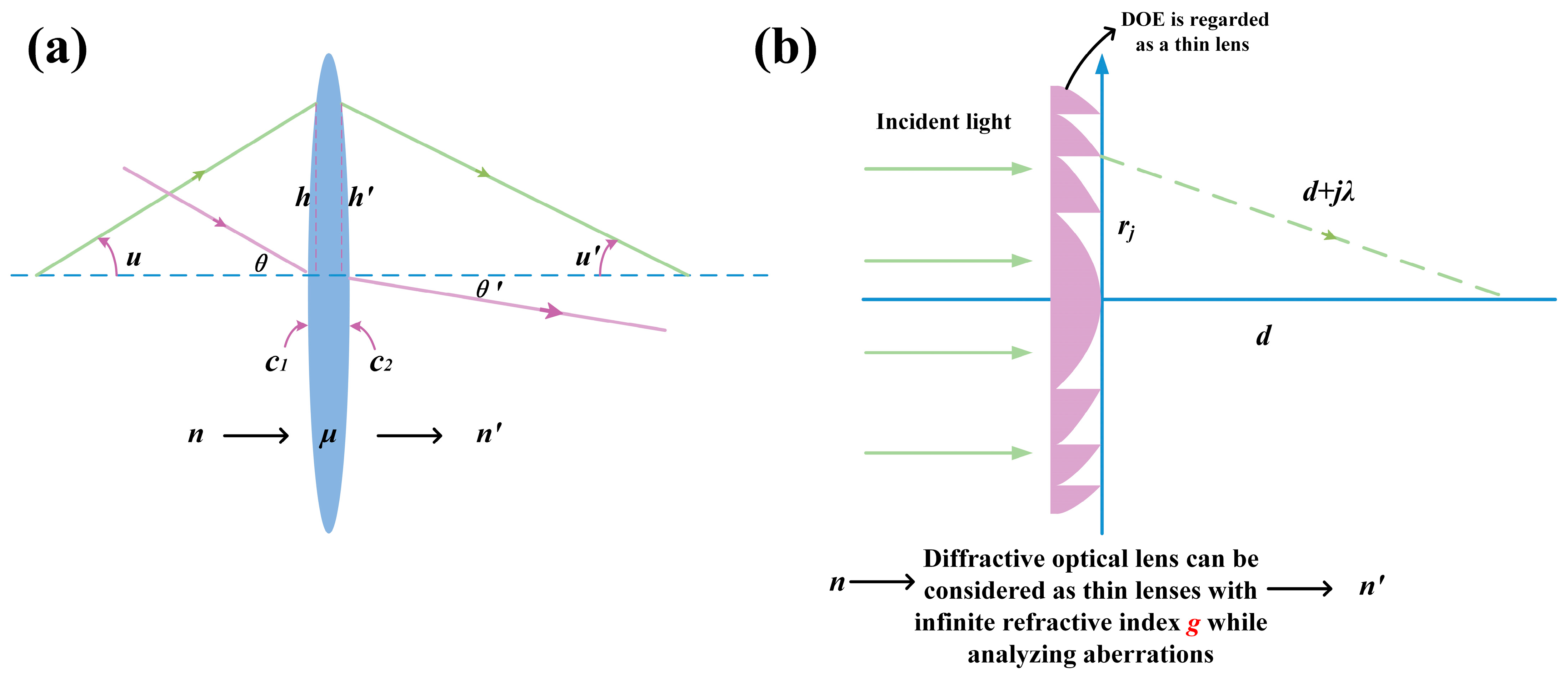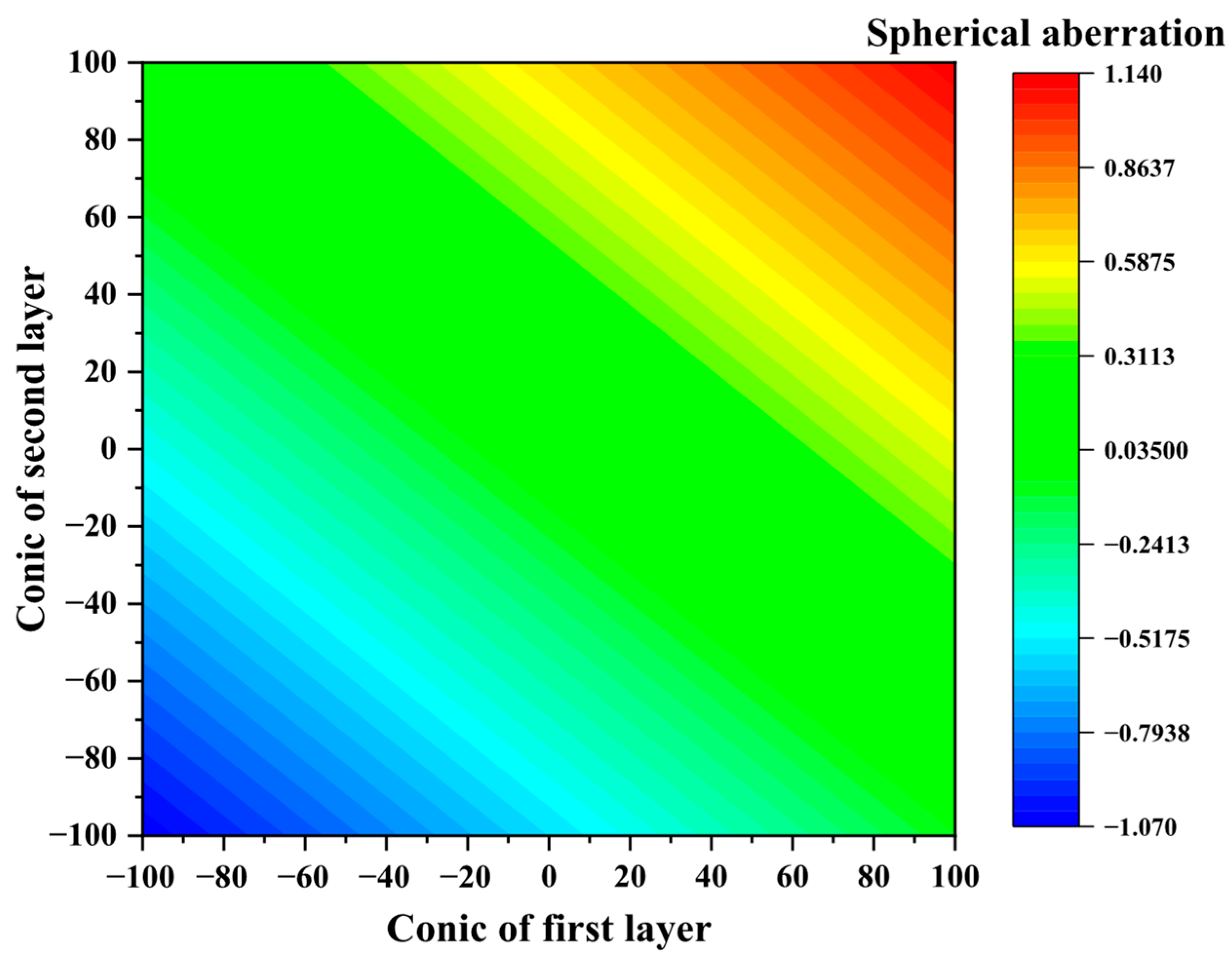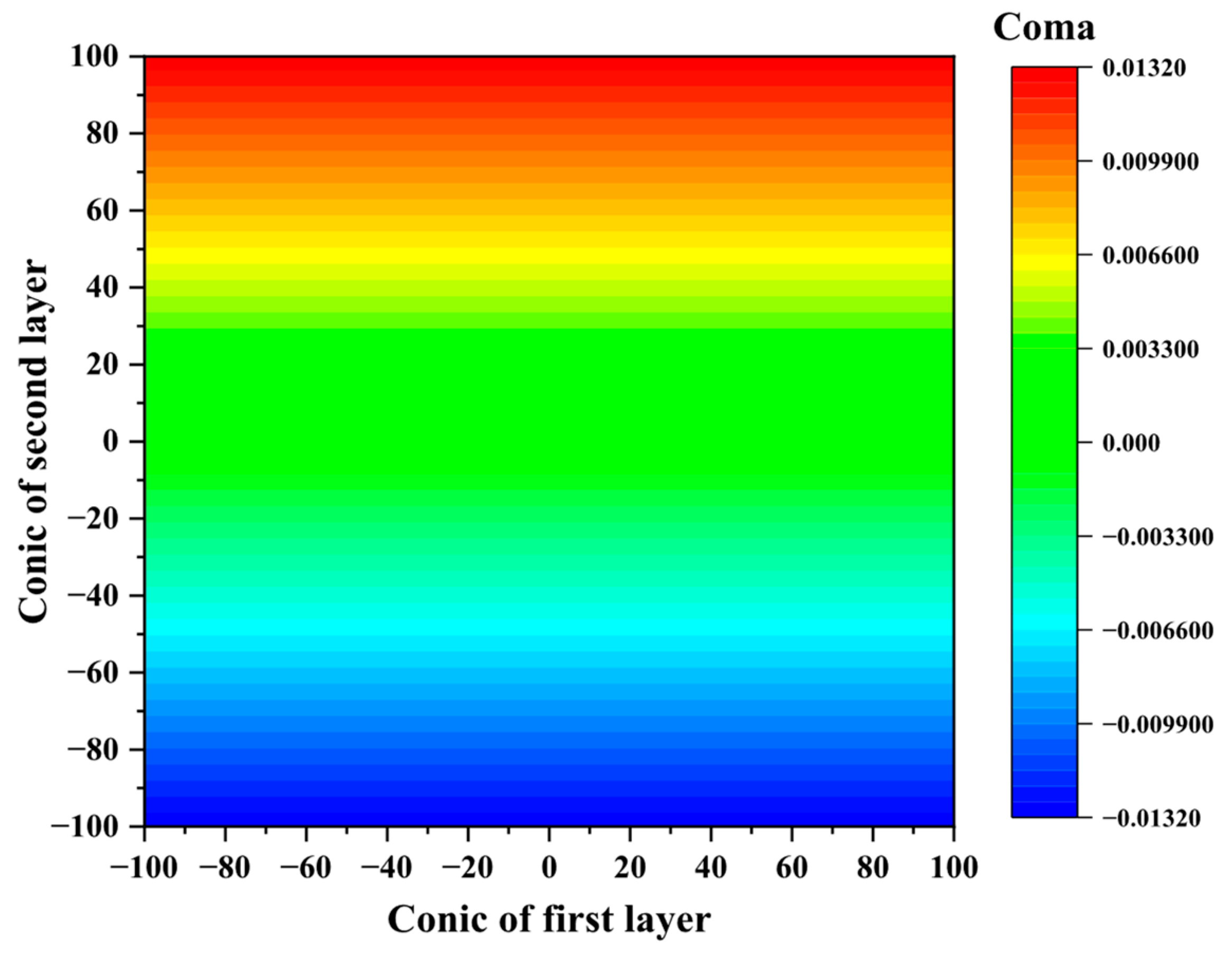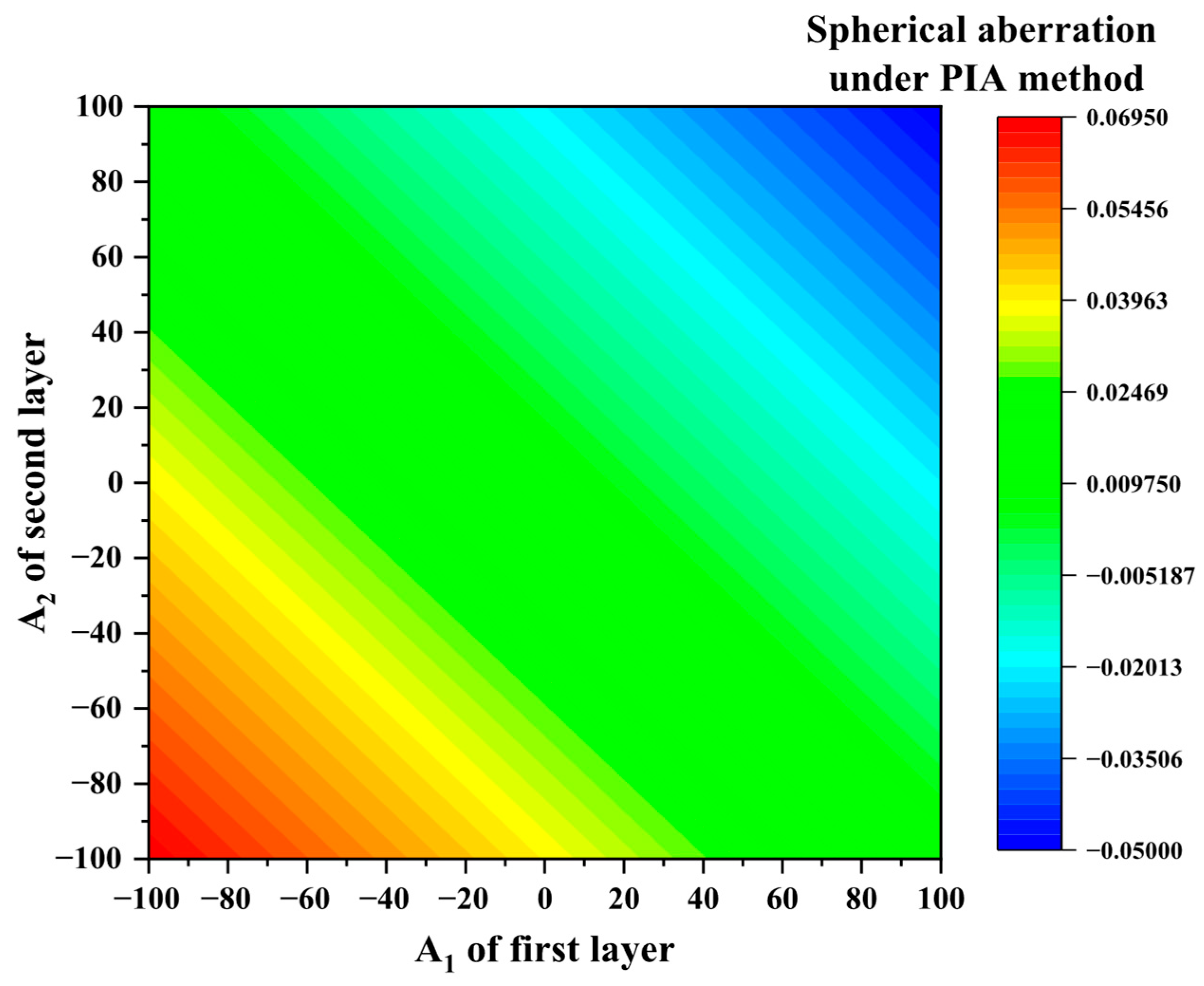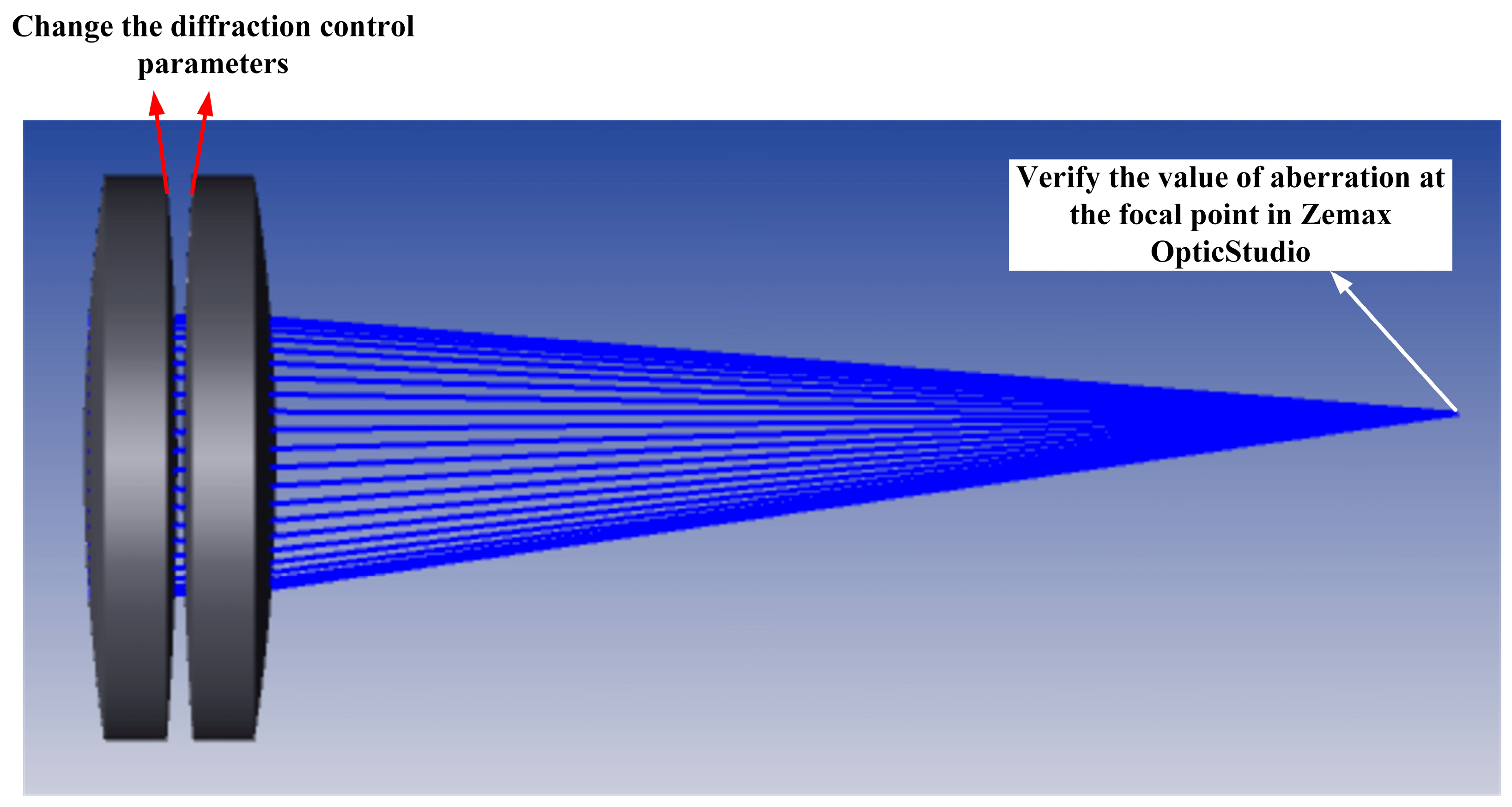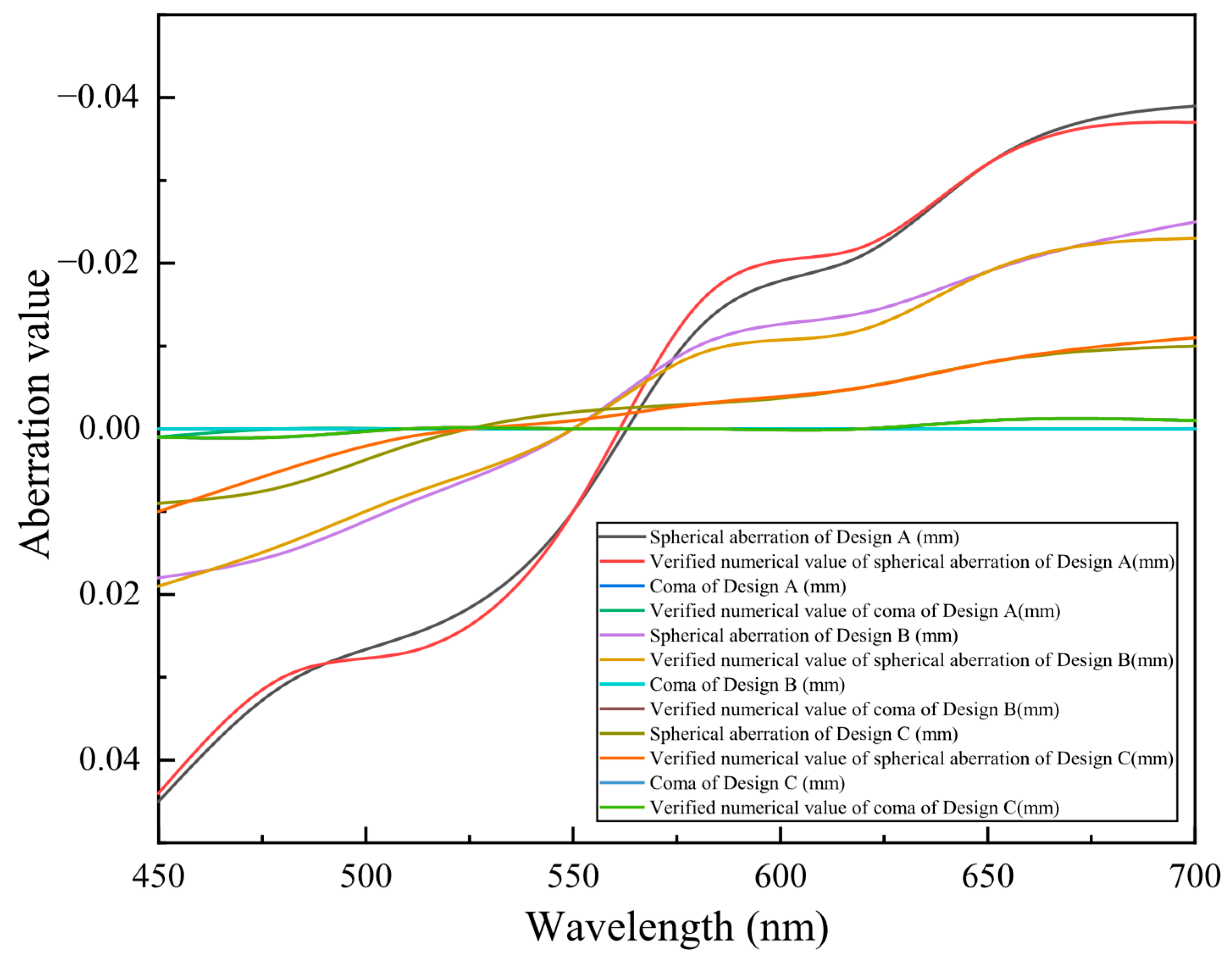1. Introduction
Multilayer diffractive optical elements, due to their excellent broadband properties [
1], arbitrary phase distribution properties [
2,
3], temperature stability properties [
4], and negative dispersion properties [
5], are widely used in the design of imaging systems [
6,
7]. Especially when multilayer diffractive optical elements are designed on refractive lenses to form multilayer refractive–diffractive optical elements to carry more functions, the number of system lenses can be effectively reduced to achieve the purpose of lightweight system design [
8].
Multilayer refractive–diffractive optical elements can achieve stable imaging in the broadband through phase transformation [
9,
10]. Buralli et al. [
11] defined the design evaluation method named polychromatic integral diffraction efficiency (PIDE) for MLDOEs with broadband imaging. Broadband MLDOEs are widely used. Piao et al. [
4] has conducted research on the design of the optimal diffraction efficiency of multilayer diffractive optical elements in a wide temperature range and broadband. Yang et al. [
12] conducted in-depth research on the broadband optimization of multilayer diffractive optical elements under extended scalar diffraction theory. However, high diffraction efficiency alone is not sufficient to guarantee excellent imaging quality. Even with extremely high diffraction efficiency, if aberrations are not effectively corrected, system performance will still be limited [
13]. For instance, severe spherical aberration or coma can lead to blurred or distorted images [
14], even when energy utilization is efficient, preventing the system from meeting the demands of high-precision imaging. Therefore, in-depth research into the aberration characteristics of MLDOEs and the development of effective control methods are crucial for achieving high-performance broadband imaging. In conclusion, the research on broadband multilayer diffractive optical elements has become a hot topic.
Overall, it can be found that the research on multilayer refractive–diffractive optical elements is limited to the study of their diffraction efficiency. For a multilayer refractive–diffractive optical element that performs both diopter and broadband imaging, the study of its aberration (corresponding to the imaging quality) is extremely necessary. However, to the best of our knowledge, there is no overall derivation of the aberration of multilayer refraction–diffraction optical elements and no research on how to achieve the aberration control theory in the broadband. This gap limits the application of MLDOEs in precision imaging, especially in fields with stringent imaging quality requirements, such as high-resolution spectrometers, medical endoscopes, and aerospace remote sensing. In these applications, relying solely on high diffraction efficiency is insufficient; the system must simultaneously exhibit extremely low aberrations to ensure image clarity and accuracy. Therefore, to overcome this issue, establishing a comprehensive aberration theory for multilayer diffractive optical elements and proposing effective broadband aberration evaluation methods are crucial for advancing the practical application of MLDOEs.
Considering the above factors, it is extremely necessary to derive the aberration theory of multilayer refractive–diffractive optical elements and propose a way to evaluate the overall aberration in the broadband. Therefore, in this paper, the aberration derivation applied to the refractive–diffractive MLDOEs was obtained. Then, the polychromatic integral aberration (PIA) method was proposed to evaluate aberration control in the broadband. The composition of other sections of the thesis is as follows: In
Section 2, the derivation of the aberrations of DOEs in air as the basics for the research is recalled. In
Section 3, the aberration expression of the multilayer diffractive optical element is derived in detail. Then, we combined the aspheric parameters of the refractive substrate and the diffractive correction parameters and obtained the aberration derivation of the multilayer refractive–diffractive optical element. By solving the average aberration in the broadband, the aberration evaluation model in the broadband—polychromatic integral aberration (PIA)—is proposed. In
Section 4, the results of the conventional multilayer refractive–diffractive optical element design method, the multilayer refractive–diffractive optical element design method only by the proposed the aberration model, and the multilayer refractive–diffractive optical element design method using the PIA method are compared and discussed. In
Section 5, the research is summarized.
2. Aberration Theory of Diffractive Optical Elements in Air
For the detailed derivation of refraction aberrations, please refer to
Appendix A in this paper; the letters in this section also refer to
Appendix A.
Figure 1a shows the optical path diagram of the refractive lenses.
c1 is the curvature the refractive lens’s front surface.
c2 is the curvature of the refractive lens’s back surface.
and
are the convergence angles of the incidence and exit light.
and
are the refractive indices of the front media and back media.
and
are the angles of the incidence and exit light.
and
are the heights of the incidence and exit light.
As shown in
Figure 1b, when employing a diffractive optical element as an aberration correction element, its behavior can be approximated by modeling it as a thin optical element with an infinite refractive index (its refractive index tends to ∞) property. This approximate method, known as the “infinite refractive index thin lens model”, is widely used in the initial aberration analysis of diffraction optical elements. Its core concept lies in the fact that the diffraction element modulates the phase of the light wave through its microstructure. This modulation effect is, in a macroscopic sense, equivalent to a lens with a specific focal length but a thickness approaching zero. Since the diffraction effect itself does not depend on the refractive index of the medium, it can be hypothetically assumed to have an infinite refractive index, thereby enabling instantaneous and ideal refraction of light when it passes through the diffraction surface. This modeling method significantly simplifies the aberration calculation, allowing it to be consistent in form with the traditional refractive aberration theory and facilitating unified analysis. However, it should be noted that this approximation may have limitations when dealing with higher-order aberrations or diffraction efficiency issues, but it has significant advantages for qualitative analysis and preliminary design of primary aberrations. At this point, the front and back surface curvatures
.
So, for the diffractive optical elements in air, i.e.,
, the diopter of the DOE, which is considered as a thin lens, can be expressed as follows:
where
is the refractive index of the DOE.
Then, further define
U by the shape factor
X (defined in
Appendix A) as
Thus, Equation (2) can be used in Equations (A4), (A6), and (A8), which are shown in
Appendix A. For example, when substituting
g → ∞ and Equation (2) into Equations (A4), (A6), and (A8),
,
(
μ =
g). Then, further simplify the aberrations as
4. Results and Discussion
To eliminate the influence of other components in the system design, we only verify the aberrations of a single multilayer refractive–diffractive diffraction optical element (PMMA and PC, the view angle is 12°, additional diopter is 2D). Verification was carried out through Zemax OpticStudio 2019. Since there is no corresponding broadband refractive–diffractive aberration design model for comparison, we designed three control experiments ourselves. The three design results are compared: the traditional multilayer diffraction optical element (Design A), the corrected multilayer diffraction optical element designed only by Equation (10) (Design B), and the multilayer diffraction optical element designed through the PIA model (Design C). Among them, Design B is designed only by Equation (10), which aims to make the spherical aberration 0 at the design wavelength of 555 nm. Design C achieves stable imaging in the broadband of 450–700 nm. The refraction part parameters of Design A, Design B, and Design C are designed exactly the same.
First, the initial structure is presented to obtain the initial design by making the coma equal to 0 for Designs A and B. For the initial curvature, we randomly adopt a structure to prove the universality of our model. At this time,
,
,
,
, the thickness is set as 1 mm for each layer, and
h1 and
h2 are set as 3 mm. Next, the aspheric control parameter is added to make the coma equal to 0 at design wavelength 550 nm (shown in
Figure 3 and
Figure 4). As can be seen from Equation (10), the conic coefficient and the fourth-order aspheric coefficient have the same effect. Therefore, we did not add the fourth-order aspheric coefficients and only regulated the conic coefficients. The conic coefficient design results are
and
. Finally, all the data are verified by Zemax OpticStudio. The results are shown in
Table 1 (To simplify the system, only the surfaces without diffraction structures are added, that is, the front surface of the first layer and the back surface of the second layer. From
Figure 3 and
Figure 4, it is indeed sufficient to complete the design requirement by adding only two surface conic parameters). This experimental design method, which involves using the control variable approach to compare the effects of different aberration optimization strategies separately, is a classic paradigm for evaluating the performance of optical systems. Design A is set as the benchmark, representing the basic MLDOE performance without aberration optimization, and its aberration performance will serve as the reference point for subsequent optimizations. Design B represents the traditional strategy of aberration correction for a single wavelength. Design C, as the core innovation of this study, demonstrates the superiority of the PIA method in balancing aberrations over a wide bandwidth. Simulation verification using Zemax OpticStudio software ensures the reliability of the experimental results. The random selection of initial parameters and the decision to only adjust the conical surface coefficients reflect the universality of the model and the simplification of analysis, avoiding the risk of overfitting to specific parameters. Setting the coma aberration to zero as the initial optimization objective enables a clearer observation of the effects of different methods on the spherical aberration and its broadband characteristics in the subsequent spherical aberration optimization process.
Figure 3 clearly shows the trend of spherical aberration changing with the adjustment of the conic. From the figure, it can be seen that there are one or more specific conics that can minimize the spherical aberration, even approaching zero. This curve relationship provides designers with intuitive guidance, enabling them to effectively control the spherical aberration by adjusting the conic in actual design.
Similar to
Figure 3,
Figure 4 depicts the relationship between the coma aberration and conic. It is worth noting that although the conic is mainly used to correct spherical aberration, it also has a certain impact on coma aberration. However, as can be observed from
Figure 4, the sensitivity of coma aberration to the conic may be different from that of spherical aberration, or its change trend may be relatively gentle within a certain range. This suggests that in the optimization process, we need to comprehensively consider the response of different aberrations to the same design parameter to achieve overall balance.
The data in
Table 1 represent the initial optimization results. The aim was to correct the coma to zero by adjusting the conic and record the spherical aberration at that time. From the table, it can be seen that the spherical aberration calculated by our proposed model (−0.011 mm) is very close to the spherical aberration verified by Zemax OpticStudio (−0.010 mm), indicating that our theoretical model has high accuracy in predicting aberrations. At the same time, the coma in both the model and the verification reached 0 mm, confirming that adjusting the conic can effectively eliminate the coma. This result lays the foundation for subsequent broadband optimization, ensuring the basic imaging quality of the system along the axis and within a certain field of view.
Then, through the regulation of diffraction control parameters
A1 and
A2, the ideal spherical aberration design aim is obtained (i.e.,
A1 and
A2 = 0 for Design A; using Equation (10) to solve for Design B; and using the PIA method—Equation (11) for Design C, shown in
Figure 5). The detailed parameters are shown in
Table 2 (normalization value). The verification optical path is shown in
Figure 6.
Figure 5 further discusses the influence of the diffraction control parameters
A1 and
A2 on spherical aberration. Similar to
Figure 3 and
Figure 4, the figure shows the curve of spherical aberration changing with the diffraction control parameters. By establishing the relationship between
A1,
A2, and aberration, we can easily obtain the combination of
A1 and
A2 for the condition of the aberration design requirement. It can be foreseen that by precisely adjusting these parameters, effective correction of spherical aberration can also be achieved. For the initial structure of this paper, we have completely corrected the coma. Then, by adjusting
A1 and
A2, we try to select values that can make the PIA = 0 in
Figure 5 to minimize spherical aberration in the broadband. This figure is crucial for understanding the role of the diffraction structure in aberration correction, revealing the influence of the diffraction phase distribution on the imaging quality along the system axis. By combining
Figure 3,
Figure 4 and
Figure 5, it is possible to more flexibly choose to correct aberrations through aspheric parameters of the refractive surface, optimization of the diffraction structure, or a combination of both to achieve the best performance.
Figure 7 presents the core experimental results of this study. It visually compares the performance of the three design schemes in terms of spherical aberration and coma at different wavelengths. It should be noted that the three designs presented in this paper are only used to verify our proposed theory and therefore do not include subsequent tolerance analysis of the system. However, if the theory is to be applied in practice, sensitivity or tolerance analysis of the system is indispensable.
For the coma part, the coma curves of the three design schemes in the figure (including the verification values) are almost completely overlapping, and they remain at a level close to zero. This strongly validates the theoretical derivation of this study—the influence of the diffraction control parameters A1 and A2 on coma is negligible. This discovery is crucial because it means that when optimizing spherical aberration, we can independently adjust these diffraction parameters without worrying about a significant negative impact on coma, thereby greatly simplifying the complexity of the multi-objective optimization process.
For the spherical aberration part, the comparison of the three curves reveals the advantages and disadvantages of different aberration optimization strategies:
Design A (traditional multilayer diffractive optical element) has a highly fluctuating spherical aberration curve throughout the entire wavelength range, with large numerical values. This indicates that without performing aberration optimization, the system’s broadband imaging quality is unacceptable. The high spherical aberration value is the main reason for image blurring and resolution degradation.
Design B (single-wavelength optimization) has its spherical aberration corrected to an extremely low level at the design wavelength of 555 nm, almost zero. This proves the effectiveness of single-wavelength optimization through Equation (10). However, once deviated from 555 nm, the spherical aberration deteriorates rapidly, especially at the ends of the wavelength band, and its value even exceeds that of Design A. This “sacrificing the global for local optimization” strategy makes the system perform well only at specific wavelengths and shows significant limitations in broadband applications. For example, in color imaging, this will result in inconsistent focusing positions for different color channels, causing color edges or blurring.
Design C (PIA method optimization) has a spherical aberration curve throughout the 450–700 nm wavelength range; although it does not reach the extreme zero point at 555 nm as in Design B, its spherical aberration values remain at a relatively low and stable level. This means that through the PIA method, the system achieves “balanced correction” of aberrations throughout the broadband range. Although it may not be the absolute best in a single wavelength, it shows good performance across all wavelengths and avoids the drastic deterioration at non-design wavelengths like Design B. This balance is crucial for broadband imaging systems, ensuring clear and consistent image quality throughout the working wavelength range.
Overall, from
Figure 7 (the lines of coma of Design A (mm), verified numerical value of coma of Design A (mm), coma of Design B (mm), verified numerical value of coma of Design B (mm), coma of Design C (mm), verified numerical values of coma of Design C (mm) almost coincide), first, it can be seen from the result that adding the parameters
A1 and
A2 has almost no effect on the coma. This also verifies our derivation. Then, it also can be found that Design A cannot fully correct both spherical aberration and coma aberration simultaneously. Design B can satisfy the correction of spherical aberration and coma at the central wavelength, but it decreases significantly throughout the entire band and cannot meet the imaging effect in the broadband. Although Design C sacrifices a certain amount of imaging quality at the central wavelength, it still retains a part of the spherical aberration. However, through the PIA design, the control of spherical aberration and coma throughout the whole waveband has been achieved, thereby realizing high imaging quality throughout the whole waveband. In conclusion, we have demonstrated the effectiveness of the PIA design, The method can be widely applied in the design of all multilayer refractive–diffractive optical systems.
Finally, we discussed the manufacturability of the method. The manufacturing shielding effect will affect the diffraction efficiency. Therefore, we need to ensure that the period width of the designed diffraction optical element is not too small. Since the additional optical power of the diffraction optical element described in this paper is very low, according to where ϕ is the additional optical power and rj is the period radius, its period radius (corresponding to the period width) is also relatively small. Thus, it will not cause excessive manufacturing shielding errors. Since the step height of the designed MLDOE is still at the micrometer level, for single-point diamond turning, the height error can be basically ignored.
5. Conclusions
Multilayer refractive–diffractive optical elements are widely used in imaging systems. In this paper, the aberration system of multilayer refractive–diffractive optical elements is derived in detail. Based on this, an evaluation method for the imaging quality of multilayer refractive–diffractive optical elements is proposed in the broadband. As the most common multilayer diffractive optical element, this paper presents the design of the double-layer diffractive optical element. Furthermore, the theory in this paper is also applicable to the design of multilayer diffractive optical elements with three or more layers. However, at this point, there are not only A1 and A2, but also parameters such as A1, A2, A3 …, to regulate. On the other hand, the aberration method presented in this paper is still applicable to subsequent analyses, such as those of wide fields of view. However, at this point, the PIA evaluation equation also needs to be integrated over the field of view, which will be studied in future work. Furthermore, the proposed lenses can be easily manufactured using methods such as single-point diamond lathes. Adding the fourth-order aspheric coefficient does not cause additional difficulties in the manufacturing process. This indicates that our method can be widely utilized.
It should be noted again that the method proposed in this paper can not only design broadband aberration-eliminating multilayer refractive–diffractive optical elements but also can use multilayer diffraction optical elements if the system needs to correct the corresponding aberrations. Correspondingly, if the imaging quality of the system is poor in a certain waveband, further improving the proposed PIA model by increasing the weight of the waveband will also be one of the future research directions.
In this paper, we only achieved the correction of spherical aberration and chromatic aberration. Of course, since this paper provides the derivation of five types of aberrations, it is impossible to fully achieve the simultaneous correction of all five types of aberrations. This would require more complex derivations and might need to rely on algorithms. Furthermore, since nano- or micrometer-sized metasurfaces can also be regarded as thin lenses, based on the theory proposed in this paper, it is of great significance to further derive an aberration system applicable to metasurfaces.
In conclusion, the establishment of the model fills the gap in the research on the imaging quality of broadband multilayer refractive–diffractive optical elements in visible light wideband and infrared broadband systems. Introducing multilayer diffractive optical elements into the traditional system not only cannot correct the aberrations of the system but will instead introduce additional aberrations, thereby affecting the imaging quality. However, through our research, not only can a multilayer diffractive optical element be used to achieve the design goals of thinness and broadband, but also the imaging quality of the system can be corrected.
Then, when applying the multilayer refractive–diffractive optical system designed based on this principle, it is very necessary to conduct a tolerance analysis on the system. Further combined with the study of its diffraction efficiency, a multilayer refractive–diffractive optical system with both high diffraction efficiency and high imaging quality will be obtained.
